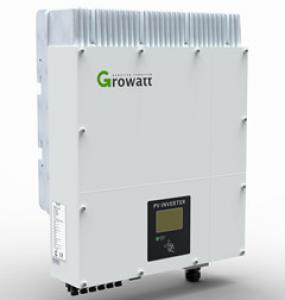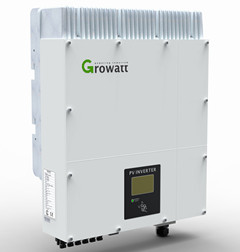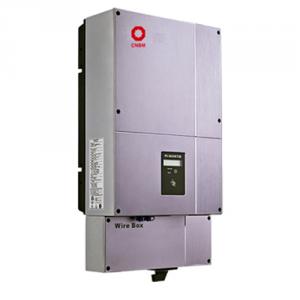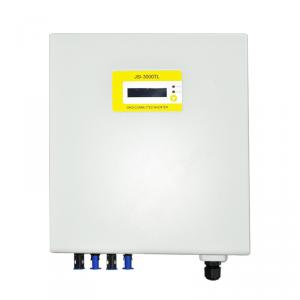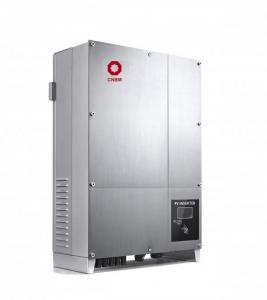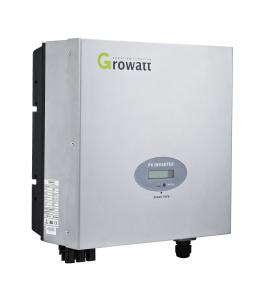Grid Connected Solar Inverter 18000-20000TL3-HE
- Loading Port:
- Shekou
- Payment Terms:
- TT OR LC
- Min Order Qty:
- 10 watt
- Supply Capability:
- 10000 watt/month
OKorder Service Pledge
OKorder Financial Service
You Might Also Like
Grid Connected Solar Inverter 18000-20000TL3-HE
Wide input voltage, DC input voltage up to 1000V
Maximum efficiency of 99%
Internal DC switch
compact design, easy maintenance
MTL-string
IP65 compatible
Easy installation
DC surge arrestor optional
RS232/485 communication interface(Wi-Fi optional)
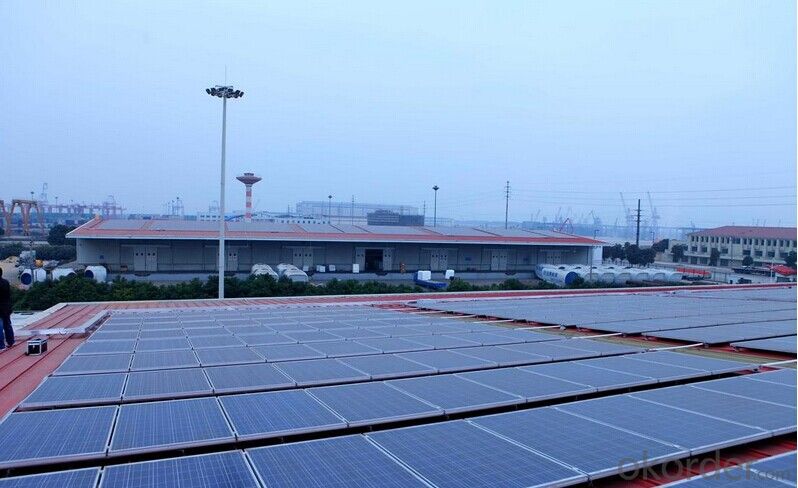
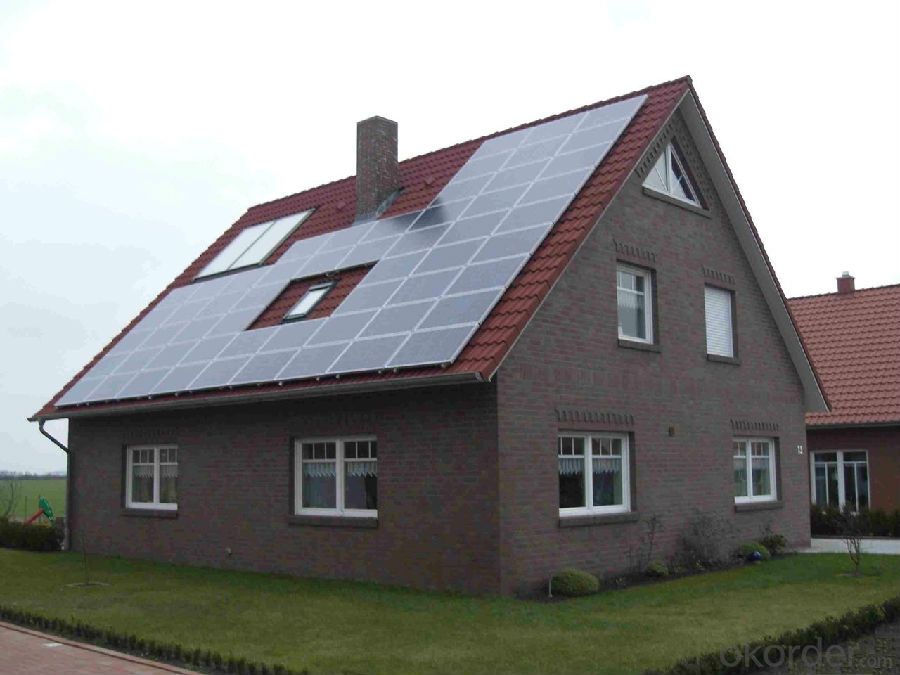
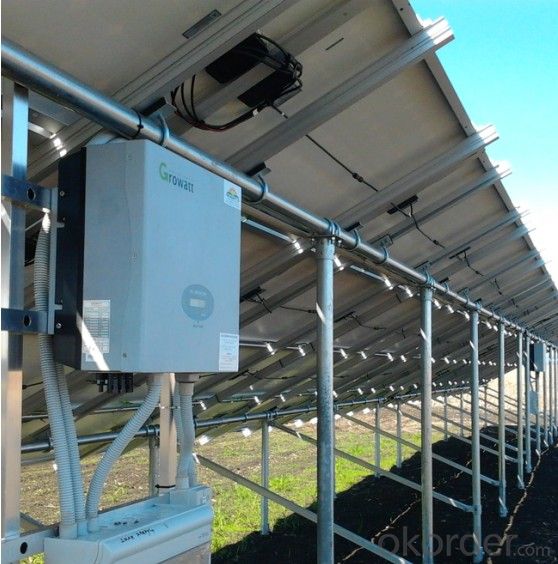
18000TL3-HE | 20000TL3-HE | ||||
| Input data | |||||
| Max.DCpower | 18700W | 20800W | |||
| Max. DC voltage | 500V | 500V | |||
| Start voltage | 400V | 400V | |||
| PV voltage range | 580V-1000V | 580V-1000V | |||
| MPP voltage range /nominal voltage | 580V-1000V/580V | 580V-1000V/580V | |||
| Full load DC voltage range | 580-800V | 580-800V | |||
| Number of MPP trackers /strings per MPP tracker | 1/6 | 1/6 | |||
| Max. input current/per string | 33A/33A | 33A/33A | |||
| Output (AC) | ||||
Rated AC output power | 18kW | 20kW | ||
| Efficiency | ||||
Max. efficiency | 99% | 99% | ||
| Protection Devices | ||||
| DC reverse polarity protection | yes | yes | ||
| DC switch rating for each MPPT | yes | yes | ||
| Output over current protection | yes | yes | ||
| Output overvoltage protection-varistor | yes | yes | ||
| Ground fault monitoring | yes | yes | ||
| Grid monitoring | yes | yes | ||
| Integrated all-pole sensitive leakagecurrent monitoring unit | yes | yes | ||
| General data | ||||
| Dimensions(W/H/D) in mm | 360/421/152 | 360/421/152 | ||
| Weight | 52KG | 52KG | ||
| Operating temperature range | -25℃ ... +60℃ | -25℃ ... +60℃ | ||
| Noise emission(typical) | ≤45dB(A) | ≤45dB(A) | ||
| Standby consumption/night consumption | <0.5W | <0.5W | ||
| Topology | Transformerless | Transformerless | ||
| Cooling concept | Natural | Natural | ||
| Environmental Protection rating | IP65 | IP65 | ||
| Altitude | 2000m without derating | 2000m without derating | ||
| Relative Humidity | 0~95% | 0~95% | ||
| Display | LCD | LCD | ||
| Interface:RS232/RS485/ Bluetooth/RF/Wi-Fi | yes/yes/ opt/opt/opt | yes/yes/ opt/opt/opt | ||
| DC connection | H4/MC4(opt) | H4/MC4(opt) | ||
| AC connection | Screw terminal | Screw terminal | ||
| Warranty: 5years/10years | yes/opt | yes/opt | ||||||||||||||
| Certificates and ApprovalsCE, VDE 0126-1-1, VDE-AR-N4105, G83,IEC 62109, CEI 0-21, AS4777, AS/NZS3100 |
- Q: What is the maximum number of MPPT inputs in a solar inverter?
- The maximum number of MPPT inputs in a solar inverter can vary depending on the specific model and brand. However, in general, solar inverters can have anywhere from one to multiple MPPT inputs, with some high-end models offering up to six or more MPPT inputs.
- Q: Can a solar inverter be used with a solar-powered lighting system?
- Yes, a solar inverter can be used with a solar-powered lighting system. A solar inverter is responsible for converting the direct current (DC) energy generated by the solar panels into usable alternating current (AC) electricity. This AC electricity can then be utilized by the lighting system for illumination.
- Q: Can a solar inverter be used in a mobile or RV application?
- Yes, a solar inverter can be used in a mobile or RV application. A solar inverter is designed to convert the DC power generated by solar panels into AC power that can be used to power appliances and devices. In an RV or mobile application, a solar inverter can help convert the solar energy into usable power for charging batteries, running appliances, and powering electronic devices on the go.
- Q: Can a solar inverter be used with a smart home automation system?
- Yes, a solar inverter can be used with a smart home automation system. Many solar inverters today come equipped with built-in communication capabilities, such as Wi-Fi or Ethernet connectivity, which allows them to be integrated into a smart home automation system. This integration enables homeowners to monitor and control their solar power production and consumption remotely through a smartphone app or a central control panel. With a smart home automation system, users can track real-time energy generation, adjust settings, and receive notifications about system performance or any issues that may arise. This integration not only enhances the convenience and efficiency of managing solar power but also allows for better optimization and synchronization with other smart devices and appliances in the home.
- Q: Can a solar inverter be used with bifacial solar panels?
- Yes, a solar inverter can be used with bifacial solar panels. Bifacial solar panels have the ability to generate electricity from both sides, capturing sunlight from the front and reflecting light from the rear. A solar inverter is responsible for converting the generated DC (direct current) electricity from the panels into AC (alternating current) electricity for use in homes or businesses. Therefore, a solar inverter is essential for connecting and utilizing the electricity generated by bifacial solar panels.
- Q: How does a solar inverter ensure safety during maintenance?
- A solar inverter ensures safety during maintenance by automatically disconnecting the system from the grid and de-energizing the circuits. This prevents any potential electrical shocks or accidents while the maintenance personnel work on the system.
- Q: Can a solar inverter be used in a building-integrated photovoltaic system?
- Yes, a solar inverter can be used in a building-integrated photovoltaic system. The solar inverter is an essential component that converts the DC (direct current) electricity produced by the photovoltaic panels into AC (alternating current) electricity that can be used to power electrical devices and appliances in a building. Therefore, it plays a crucial role in ensuring the seamless integration of solar energy into the building's electrical system.
- Q: Can a solar inverter be used in a solar-powered telecommunications system?
- Yes, a solar inverter can be used in a solar-powered telecommunications system. The solar inverter is responsible for converting the direct current (DC) produced by solar panels into alternating current (AC) that can be used to power various devices in the system, including telecommunications equipment.
- Q: What is the role of a solar inverter in grid management and stability?
- The role of a solar inverter in grid management and stability is crucial in integrating solar power into the existing electrical grid system. Solar inverters are responsible for converting the direct current (DC) electricity generated by solar panels into alternating current (AC) electricity that can be used by homes and businesses or fed back into the grid. In terms of grid management, solar inverters play a vital role in maintaining the stability and reliability of the electrical grid. They provide grid support functions such as voltage regulation, frequency control, and reactive power compensation. By monitoring the grid conditions and adjusting the output of solar power accordingly, inverters help to balance the supply and demand of electricity in real-time, ensuring grid stability. Solar inverters also contribute to grid stability by improving power quality. They actively filter out harmonics, voltage fluctuations, and other electrical disturbances that can be caused by the intermittent nature of solar power generation. This ensures that the electricity generated by solar panels is of high quality and does not introduce any disruptions or damage to the electrical grid. Furthermore, solar inverters enable the seamless integration of solar power into the grid, allowing excess energy to be fed back into the system. This is known as net metering or feed-in tariff programs, where solar energy producers can receive compensation for the surplus electricity they produce. With the help of inverters, the generated solar energy can be efficiently transferred to the grid, reducing the reliance on traditional fossil fuel-based power generation and promoting renewable energy integration. Overall, the role of a solar inverter in grid management and stability is to ensure the smooth integration and optimal utilization of solar power, while maintaining the stability, reliability, and quality of the electrical grid. It acts as a bridge between solar energy producers and the grid, facilitating the efficient and sustainable integration of renewable energy sources into the existing power infrastructure.
- Q: Can a solar inverter be connected to a home automation system?
- Yes, a solar inverter can be connected to a home automation system. By integrating the solar inverter with the home automation system, homeowners can monitor and control their solar power production, track energy usage, and automate various energy-saving functions such as adjusting thermostat settings, turning off appliances, or scheduling energy-intensive tasks during peak solar production hours. This integration enhances the overall efficiency and convenience of managing solar energy within a smart home environment.
Send your message to us
Grid Connected Solar Inverter 18000-20000TL3-HE
- Loading Port:
- Shekou
- Payment Terms:
- TT OR LC
- Min Order Qty:
- 10 watt
- Supply Capability:
- 10000 watt/month
OKorder Service Pledge
OKorder Financial Service
Similar products
Hot products
Hot Searches
Related keywords
